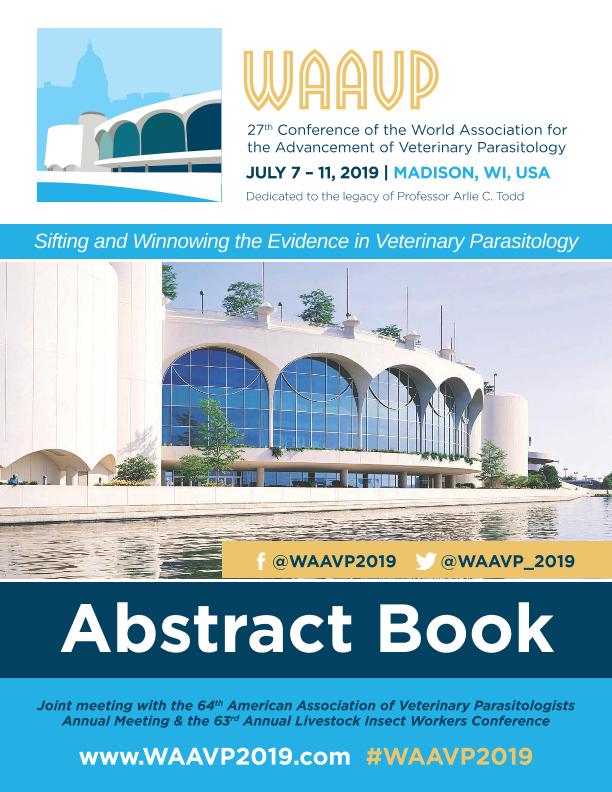Evento
Combined use of ivermectin and levamisole to control resistant nematodes in cattle: assessment of pharmacokinectic interactions and therapeutic responses
Cantón, Candela ; Ceballos, Laura
; Ceballos, Laura ; Moreno Torrejon, Laura
; Moreno Torrejon, Laura ; Dominguez, Maria Paula
; Dominguez, Maria Paula ; Cantón, Lucila
; Cantón, Lucila ; Lanusse, Carlos Edmundo
; Lanusse, Carlos Edmundo ; Alvarez, Luis Ignacio
; Alvarez, Luis Ignacio
 ; Ceballos, Laura
; Ceballos, Laura ; Moreno Torrejon, Laura
; Moreno Torrejon, Laura ; Dominguez, Maria Paula
; Dominguez, Maria Paula ; Cantón, Lucila
; Cantón, Lucila ; Lanusse, Carlos Edmundo
; Lanusse, Carlos Edmundo ; Alvarez, Luis Ignacio
; Alvarez, Luis Ignacio
Tipo del evento:
Conferencia
Nombre del evento:
27º Conference of the World Association for the Advancement of Veterinary Parasitology
Fecha del evento:
07/07/2019
Institución Organizadora:
World Association for the Advancement of Veterinary Parasitology;
Título del Libro:
Abstract Book: 27th Conference of the World Association for the Advancement of Veterinary Parasitology
Título de la revista:
REVISTA DEL CONGRESO
Editorial:
World Association for the Advancement of Veterinary Parasitology
Idioma:
Inglés
Clasificación temática:
Resumen
Combination of anthelmintics with different mechanisms of action has been suggested as an effective strategy to delay the development of resistance. In this context, the current study evaluated the efficacy and the potential pharmacokinetic(PK) interactions occurring after the subcutaneous administration of ivermectin(IVM) and levamisole(LEV) given both separately and co-administered to calves in two commercial farms(A and B). Sixty(60) male calves naturally infected with gastrointestinal nematodes were randomly allocated into four groups (n= 15): Control: animals did not receive anthelmintic treatment; IVM: treated with IVM(0.2 mg/kg); LEV: treated with LEV(8 mg/kg); IVM+LEV: simultaneously treated with IVM and LEV(at the same dose rates). Seven(7) animals from each treated group(Farm A) were randomly selected to perform the PK study. Drug concentrations were measured by HPLC. The efficacy was determined at 14 days after treatment by the FECRT. The IVM area under the concentration vs time curve(AUC) obtained after administration of IVM alone (274±65.1ng.d/mL) was similar to that obtained after IVM co-administered with LEV (295±111 ng.d/mL). Likewise, LEV AUC values were similar after LEV administration alone (8.90±2.69 µg.h/mL) or combined with IVM (9.11±1.82 µg.h/mL). No adverse PK interactions were observed after the combined treatment, with similar PK parameters (P>0.05) obtained between the single-drug and combination-based strategy. In Farm A, the overall efficacies were 54%(IVM), 99%(LEV) and 100%(IVM+LEV). While Cooperia spp. survived IVM treatment, Ostertagia spp. survived LEV treatment. In fact, the efficacy against Cooperia spp. was 41%(IVM), 100%(LEV) and 100%(IVM+LEV), and the efficacy against Ostertagia spp. was 91%(LEV), 100%(IVM) and 100%(IVM+LEV). Similarly, in Farm B, total efficacies were 55%(IVM), 99%(LEV) and 100%(IVM+LEV). Although LEV alone achieved high efficacy in both farms, the combination was the only treatment that achieved 100% efficacy against all genera (Cooperia, Ostertagia and Haemonchus). Further work is required to understand the advantages of nematodicidal combinations in different commercial cattle farms.
Palabras clave:
ANTHELMINTHICS
,
CATTLE
,
PHARMACOKINETICS INTERACTIONS
Archivos asociados
Licencia
Identificadores
Colecciones
Eventos(CCT - TANDIL)
Eventos de CTRO CIENTIFICO TECNOLOGICO CONICET - TANDIL
Eventos de CTRO CIENTIFICO TECNOLOGICO CONICET - TANDIL
Eventos(CIVETAN)
Eventos de CENTRO DE INVESTIGACION VETERINARIA DE TANDIL
Eventos de CENTRO DE INVESTIGACION VETERINARIA DE TANDIL
Citación
Combined use of ivermectin and levamisole to control resistant nematodes in cattle: assessment of pharmacokinectic interactions and therapeutic responses; 27º Conference of the World Association for the Advancement of Veterinary Parasitology; Madison; Estados Unidos; 2019; 323-323
Compartir



